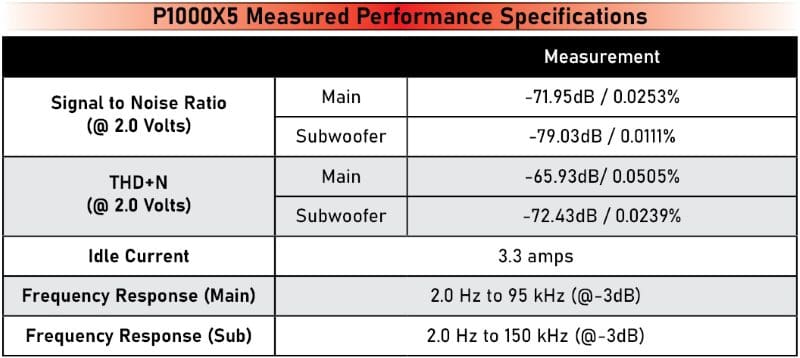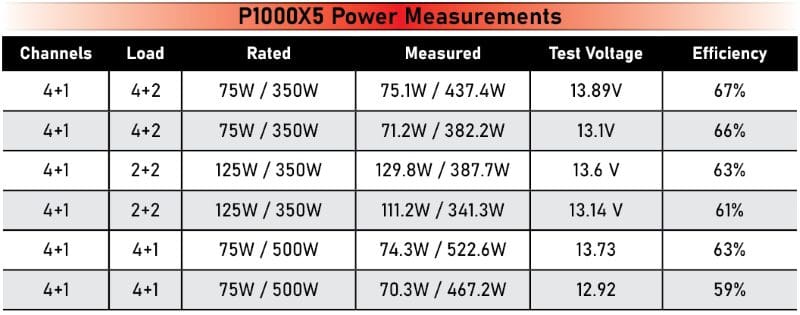If you grew up with car audio systems in the ’80s and early ’90s, you know how rare it was to see an amplifier with more than four channels. In the last decade, amplifiers with more than four channels have become popular solutions to simplify the installation of elaborate active audio systems. The car audio fanatics at Rockford Fosgate created the five-channel Punch-Series P1000X5 amplifier for enthusiasts looking for impressive sound quality, excellent reliability and all the features your installer will need to complete a premium car audio system upgrade from a single-chassis solution. Let’s take a deep dive into the specifications and performance of this potent system amplifier.
Rockford Fosgate P1000X5 Features and Specifications
The P1000X5 amplifier is rated to produce 75 watts from its four main channels and 150 watts from the subwoofer channel when driving 5-ohm loads. Those power ratings jump to 125 watts from the mains and 300 from the sub channel when driving 2-ohm loads. Your installer can wire the sub channel to a 1-ohm load, and the amp will produce up to 500 watts of power. The front channel pairs can be bridged to drive a single 4-ohm load with 250 watts of power if required by your application.
From a sound-quality standpoint, the P1000X5 combines a Class AB output device design with Rockford Fosgate’s Class BD switching topology for the subwoofer channel. In my opinion, this is the best of both worlds. Class AB amps don’t need filter networks on the outputs of the transistors, so their output impedance is lower, and the signal isn’t affected by load impedance as much. Conversely, the efficiency of a switching design for the subwoofer offers a dramatic improvement in efficiency where it matters. The electrical systems in modern cars and trucks are shrinking compared with what was available a decade ago. Making the best use of the energy the alternator can produce is important.
Like other amps in the Punch Series, the P1000X5 is based on a powder-coat-finished cast aluminum heatsink that includes flow-through perimeter ventilation and a high-mass design. All the connections to the amp are made along the front edge. A large terminal block on the right side of that front panel will accept four-AWG power and ground cables. Three sets of four-position terminal blocks on the left side of the end panel will accept up to eight-AWG wires for the connections to the speakers. There are six RCA jacks in the center of the panel, a set of RJ-style connectors for the optional PLC2 Remote Level Control connection, and an output to feed that level control signal to other amplifiers.

All but one of the configuration switches and controls are on top of the amplifier and are concealed under a removable aluminum panel that covers the front half of the amp. Each pair of channels has a sensitivity control that’s adjustable from 150 millivolts up to an impressive 12 volts. An essential benefit of this high-voltage compatibility is that the inputs can be used with the radio’s speaker outputs. Crucially, all the RCA input connections feature balanced differential inputs to prevent ground loops and eliminate EMI noise that the interconnect cables might have picked up. As such, your installer should be using twisted-pair interconnects with this amp.
The front and rear channel main channel pairs have independently adjustable electronic crossovers operating in high- or low-pass modes with a -12dB/octave slope. The crossover frequencies are adjustable between 50 and 250 hertz. The subwoofer channel has a selectable infrasonic filter fixed at a nicely chosen 28 hertz. All three sets of channels also have dedicated Punch EQ controls. They add 18 dB of boost at 45 hertz at their maximum. The Punch EQ circuit adds 14 dB of high-frequency boost centered at 12.5 kHz on the front or rear channels. If you need to add a little rumble and sizzle to your audio system, this is the EQ for you!
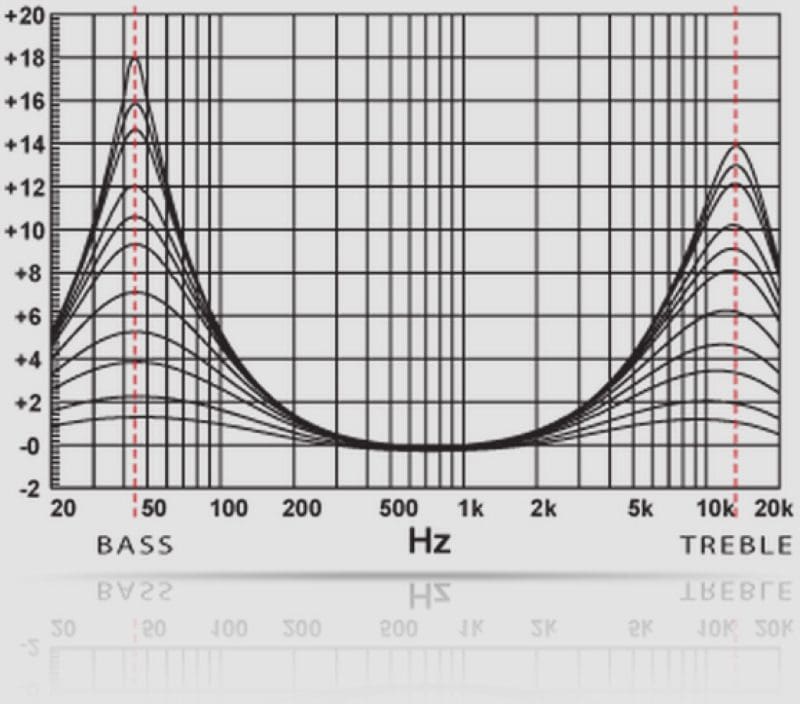
There’s a switch to activate the optional PLC2 remote and a second switch to route audio signals from the dedicated subwoofer RCA input jacks to the subwoofer channel or source audio from the front and rear inputs. A switch on the end panel allows your installer to select between two- and four-channel inputs. In short, you can run this entire five-channel amp from a single pair of RCA jacks or add fader control with a second set and source-unit subwoofer level control with a third. Another option is to use this amp with a digital signal processor like the DSR1 and create a three-way active system with a subwoofer, midrange speakers and tweeters, each on their own channels with complete control over crossover frequencies, levels, signal delay and equalization.
Rockford Fosgate has included their C.L.E.A.N. Set-Up distortion detection circuit on each pair of amplifier channels. The LEDs on top of the amp will illuminate blue with a test tone, typically 40 Hz or 1 kHz, driving the outputs to a distortion level of about 1%. This feature makes setting up the amp quick and easy, especially on the subwoofer channel.
With decades of experience creating premium car audio amplification solutions, Rockford Fosgate has filled this amp with its best technologies. Thermal management for the output and power supply switching devices is aided by the MEHSA3 MOSFET mounting method. Distortion is reduced by the short TRANS•ana signal path used on the main channels. Of course, their NOMAD real-time fault monitoring computer oversees the operation of the amplifier and watches for faults to ensure that it remains reliable for many years. Those inexpensive amplifiers on the internet don’t have features like this, and their performance and longevity suffer for it.
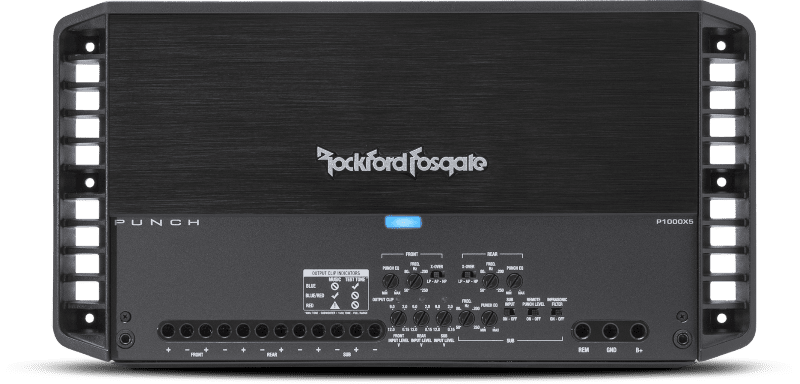
Rockford Fosgate includes a bag with appropriately sized mounting screws for the amp and a 3 mm Allen wrench for removing the top cover and completing the installation. The P1000X5 has a one-year warranty against manufacturing defects, but that can be doubled to two years if your installer uses a Rockford Fosgate amplifier installation like the RFK4 or RFK4X. All Rockford Fosgate installation kits use full AWG-spec all-copper power and ground cables and include high-quality fuse holders.
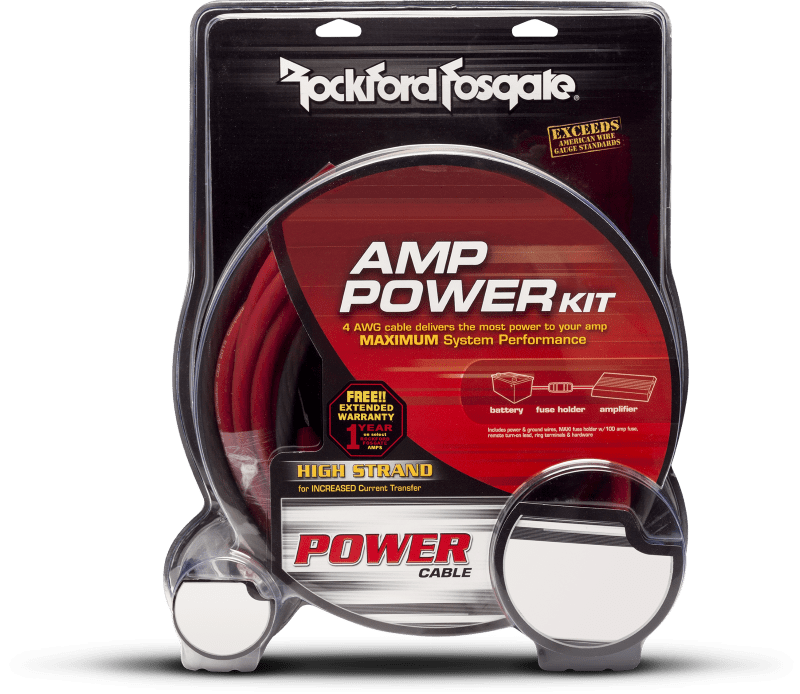
What Lurks Under the Hood of the P1000X5?
Before I brought the amp to life in the listening room, I wanted to look inside. You can tell a lot about an amplifier manufacturer by the way they build their products. The first thing I noticed was the design of the heatsink. Rockford Fosgate knows that thermal stability is crucial to longevity and happy clients. The heatsink puts a large mass of aluminum under the output and switching devices. Those areas are then surrounded by openings and cavities that allow the heat to escape into the vehicle. It’s also worth noting that the amp doesn’t buzz or rattle when shaken – it’s rock solid.
The circuit board is beautifully laid out and is densely populated, primarily with modern surface-mount devices. Six vertically mounted daughterboards also use surface-mount components. The two boards closest to the connections are for the amplifier’s controls and adjustments. Just above those is a board for the switching power supply controller. The driver board for the Class BD output subwoofer stage is to the left. The upper-left boards are the drivers for the Class AB front and rear channels.
There is a bank of six 330-microfarad caps across the power input terminals, two 4,700-microfarad 50-volt and two 6,300-microfarad 63-volt caps across the power supply output rails. All the capacitors, along with the main multiple-winding transformer and the Class BD output filter, are secured together and to the main board with healthy doses of silicone sealant. Along the same lines, the removable cover over the controls has a large foam pad underneath it to ensure that it doesn’t rattle or vibrate. Ensuring that nothing vibrates while the vehicle is driving or a high-SPL system is playing is crucial to the longevity of the amplifier.
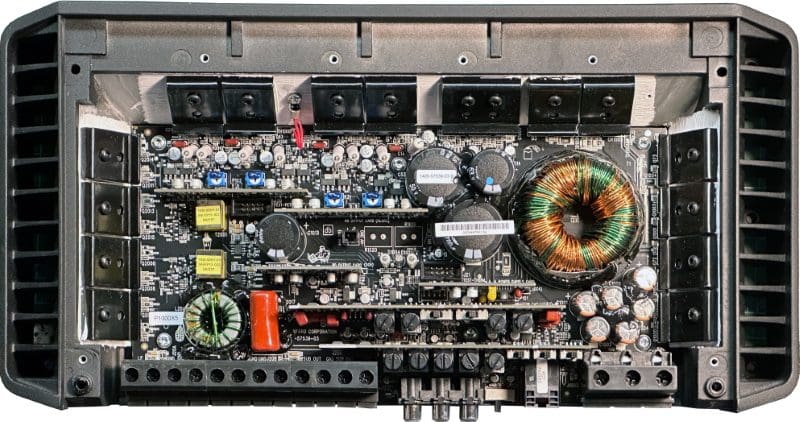
Auditioning the P1000X5 Amplifier
Before I put the amp through its paces on my test bench, I set it up in my reference system for a listen. The amp was fed by two sets of channels from my modified DRZ9255 source unit and connected to a pair of home-audio bookshelf speakers and an audiophile-grade car audio subwoofer. I use the source unit’s electronic crossovers and signal delays to split the audio signals between the main speakers and the subwoofers. I also take the time to ensure that the relative level of the main channels to the subwoofer is the same, so I know anything I hear isn’t a variation based on a setting as opposed to a characteristic of the amplifier.
The first track I played was “Resistor” by Yello. This track is primarily synthesizer effects and samples with lots of panning and vocal processing. While it’s not the typical jazz or isolated vocal recording most would use to evaluate an audio component, getting it to sound right takes all the same qualities from a good audio system. The P1000X5 sounded great. The pans were smooth, and there was no sense of sibilance or harshness anywhere. The bass was solid and blended beautifully with the midbass and midrange.
Up next was “Thunderstruck” by AC/DC. The guitar in the opening was clean, and each note was nicely defined. When the kick drum came in, you could tell it was a drum and could hear the definition of the hammer hitting the skin. It wasn’t just a computer beat but a real instrument.
It’s pretty easy to tell when an amplifier is doing a good job and when nobody cares about making it sound good. The Rockford Fosgate P1000X5 sounded excellent. I finished the listening session with Adele’s “Take it Easy On Me.” I’ve listened to this track a few times, and it’s easily got some of the most overprocessed vocals in modern music. There’s zero variation in the level and intensity of her voice. Ultimately, that makes her sound fake. She sounds worse when played back on a good amplifier like the P1000X5 because the playback is so clear. That’s perhaps a drawback of good quality equipment – when a recording is terrible, it’s easy to pick that out. So, thanks, Rockford Fosgate and sorry, Adele.
Lab Testing the Rockford Fosgate P1000X5
The first lab tests confirm the operation of the built-in high-pass and low-pass crossovers on the main channels and the low-pass and infrasonic filters on the subwoofer channel. The graphs below show the filters are -3 dB at the crossover point, as would be consistent with the -12 dB/octave filters. Your installer will want to underlap the mains to the subwoofers a little bit to get them to sum flat. In terms of absolute frequency response, the main channels are -3 dB at 2 hertz on the bottom and over 95 kHz on top. The subwoofer channel with the infrasonic filter disabled is a -3 dB at 2 hertz on the bottom. If you like to rumble, this amp is a perfect choice!
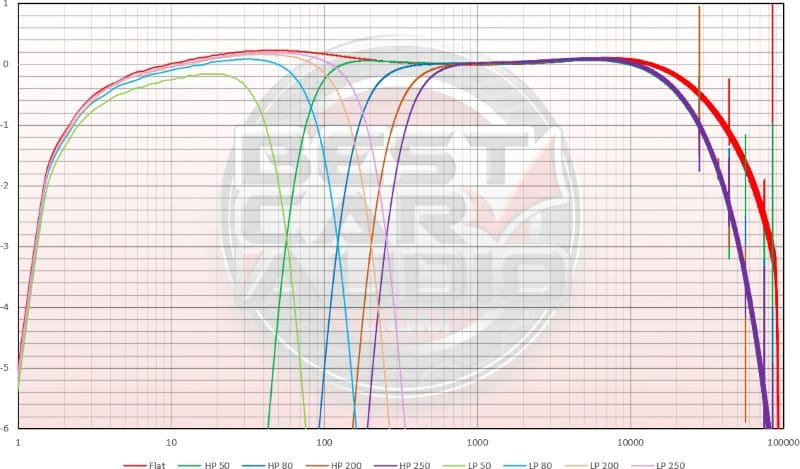
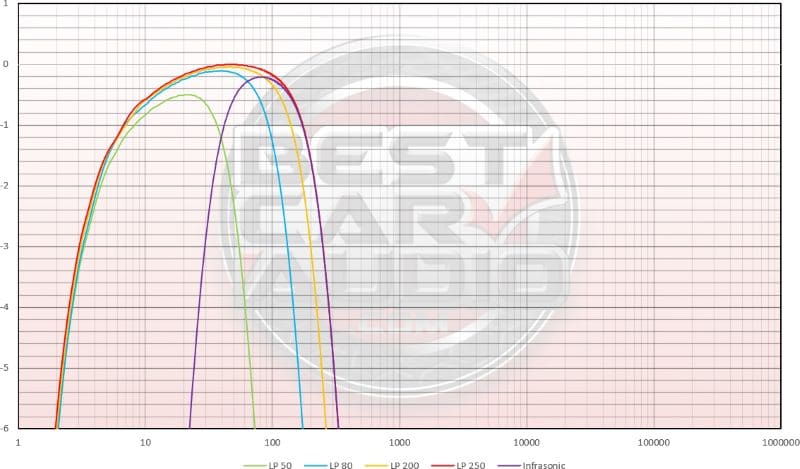
If you look closely at the red reference curve in the main channel response graph, you’ll see a bit of Rockford Fosgate’s Punch Equalization. There’s 0.2 dB of boost at 50 and 0.1 dB up at 7 kHz. This isn’t enough to make the amp sound boomy or sizzly, but it makes it a lot of fun!
Speaking of bass and treble boost – the next set of response measurements shows the effect of the Punch EQ circuit on the main channels with the crossovers turned off, and the subwoofer channel with the low-pass crossover at its highest setting and the infrasonic filter turned off. As with any amplifier, if your installer dials in some equalization on the bottom end, the gain control needs to be turned down by the equivalent amount to prevent the amp from distorting when driven hard.
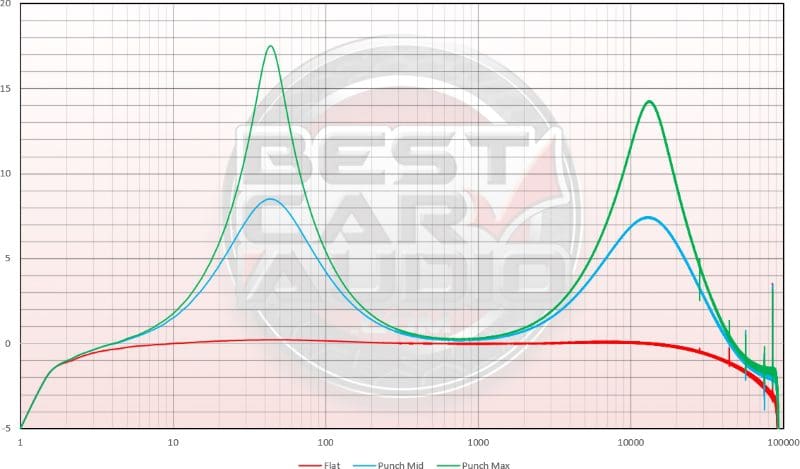
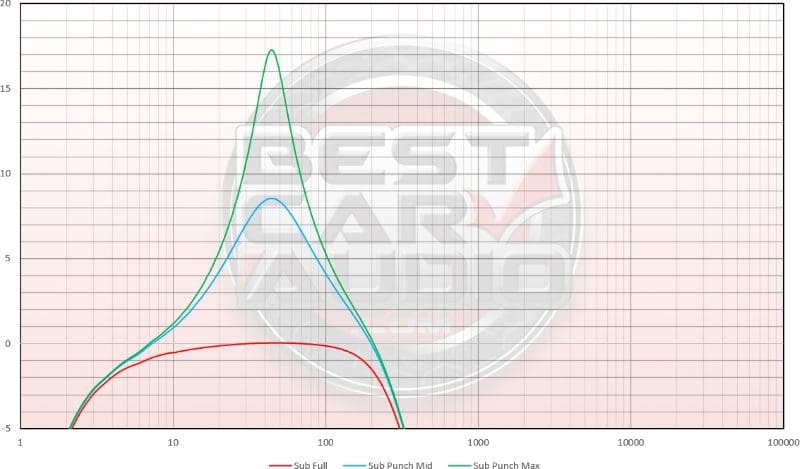
I looked at distortion characteristics next. I measured the THD+N of the main channels with a 2-volt output signal to comply with the ANSI/CTA-2006-C standard used by reputable car audio product manufacturers. I tested the subwoofer channel noise and distortion using a 50-hertz and the main channels with a 1-kHz test tone.
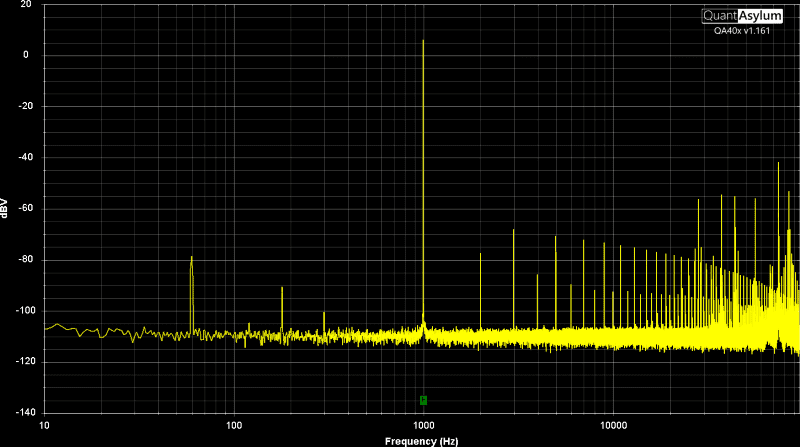
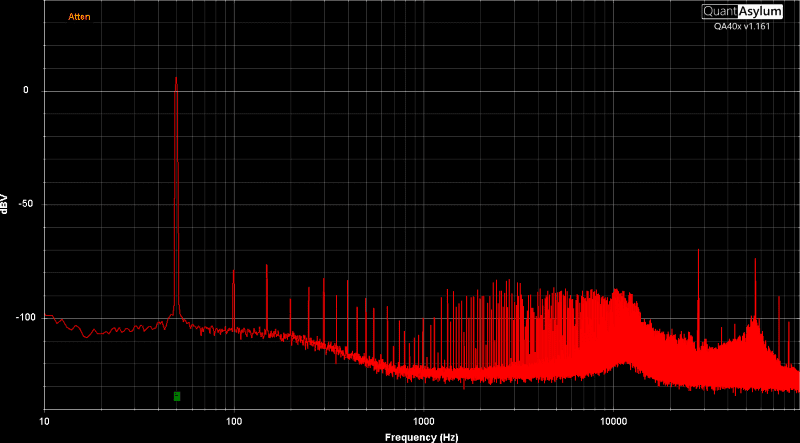
The amp did well in terms of distortion. Any amplifier substantially under 0.075% total harmonic distortion and noise at 2 volts of output is likely to be a solid performer. The signal-to-noise ratio was also good at just under 70 dB for the main channels.
I can’t grasp the confusion about the correlation between power production and audio product quality. Nevertheless, the P1000X5 behaved flawlessly when driven hard, and the transformer in the amp didn’t make a peep, no matter what I did to it. As you can see from the table below, the amp would dramatically exceed its power ratings with more voltage. As it was, with about 13.9 volts at the terminals, it still cranked out the juice.
Last but certainly not least, I let the amp play with the main channels wired to four 2-ohm loads and the subwoofer channel connected to a 1-ohm bank of resistors. I used my FLIR thermal imaging camera to monitor the heatsink’s temperature and made recordings at one-minute intervals. At full power into its lowest-rated impedances, the Rockford Fosgate P1000X5 played for 11 minutes before the thermal protection circuit shut it down. After the amp cooled for a few minutes, it resumed playing. The chances of music putting this much thermal strain on an amplifier is zero. You’d have to play 50-hertz test tones through all five channels simultaneously. With music, even with the amplifier tickling the C.L.E.A.N. distortion indicators, there is more than enough thermal mass to keep the amp cool so it can play for hours.
A Great Five-Channel Car Audio Amplifier
Stepping back and looking at the big picture, Rockford Fosgate’s Punch-Series P1000X5 is an excellent solution for someone who wants a reliable, great-sounding amplifier for their car audio system. Whether driving a set of front and rear speakers with a sub or used in conjunction with a DSP to create a three-way system with a subwoofer, midrange drivers and a tweeter, everything about the amp lines up to deliver outstanding performance. It also makes enough power to melt all but the most robust of speakers, and with more than 500 watts available for the sub, it’ll keep those who love some rumble happy. Most importantly, the design is rock solid, and the amplifier sounds great – something that many enthusiasts overlook because they are focused on price rather than performance.
When it’s time to upgrade your audio system, drop by a local authorized Rockford Fosgate retailer and ask about the Punch P1000X5 five-channel system amplifier. You can find a shop using the Dealer Locator on their website. Be sure to follow Rockford Fosgate on YouTube as their marketing team puts out some of the coolest videos in the car audio industry. Oh, their Facebook Page and Instagram are updated regularly with great content, too.

